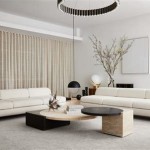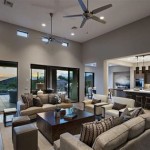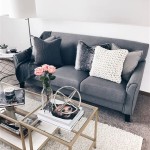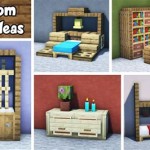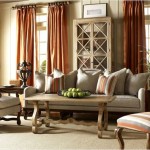How to Decorate Your Walls with a TV: A Comprehensive Guide
Integrating a television into a room's décor presents a unique challenge. The television, a dominant technological element, necessitates careful consideration to ensure it complements, rather than clashes with, the overall aesthetic. This article provides a detailed guide to effectively decorate walls while incorporating a television, offering practical advice and design principles to achieve a balanced and visually appealing space.
Planning and Preparation: Laying the Groundwork
Before mounting or placing a television, a thorough planning phase is essential. This foundational step significantly influences the final outcome. Firstly, assess the room's layout and natural light sources. Consider where furniture will be placed and the viewing distance from potential seating arrangements. Measure the available wall space, including height and width, to determine the appropriate television size. Additionally, evaluate the existing electrical outlets and cable access points. Consider whether existing infrastructure can accommodate the television and associated components, such as a soundbar, gaming consoles, and streaming devices. If needed, plan for electrical work and cable management solutions, such as in-wall wiring, to ensure a clean and organized appearance. Finally, determine the desired viewing height. The center of the screen should ideally align with the viewer's eye level when seated. This consideration is pivotal to optimize the viewing experience and prevent neck strain.
Mounting Options and Positioning Strategies
The method of mounting a television significantly impacts the decorative approach. Several options are available, each offering distinct aesthetic and functional advantages. Wall-mounting, perhaps the most popular choice, maximizes space and provides a clean, minimalist look. Various wall mounts exist, including fixed, tilting, and articulating arms. Fixed mounts offer the sleekest appearance, while tilting mounts enable adjustments to reduce glare. Articulating mounts provide the greatest flexibility, allowing the television to be angled and extended for optimal viewing from various positions. Alternatively, a television can be placed on a media console, entertainment center, or even a custom-built cabinet. This approach provides storage space for media components and can visually anchor the television within the room's design. Consider the placement of the television relative to other design elements. Centering the television on a wall or above a fireplace are common strategies, but off-center placements can often lead to a more dynamic effect. Factor in the size and shape of the room, and the overall design style to select the most appropriate approach.
Color Coordination and Wall Textures
Color and texture play crucial role in integrating TV into the room's design. The wall color surrounding the television significantly impacts the visual impact. A neutral wall color, such as white, gray, or beige, provides a clean backdrop that allows the television to blend seamlessly. Using a darker color can also create a more theater-like environment and draw attention to the screen, although it may make the television seem more prominent. For a bolder approach, consider using an accent wall behind the television. This can incorporate colors that complement the room's existing palette or create a contrasting focal point. The texture of the wall surface can also influence the overall aesthetic. Smooth walls provide a modern and minimalist appearance. Textured walls, such as those featuring brick, wood paneling, or wainscoting, can add visual interest and warmth. Ensure the wall texture does not distract from the viewing screen. The texture should complement, rather than compete, for attention with the television. The use of these elements should be thought out in a holistic design approach.
Incorporating Design Elements Around the TV
The area surrounding the television provides an opportunity to enhance the décor and create a cohesive design theme. One popular approach is to frame the television with artwork, prints, or photographs. These elements can mirror the existing color palette of the room or introduce contrasting colors and patterns to create balance. Symmetry, like with a gallery wall, can give a organized, neat appearance to the wall space. Consider adding shelves or floating media consoles above, below, or to the sides of the television to create a functional and visually appealing arrangement. These shelves can display books, decorative objects, houseplants, and other items that reflect the homeowner's personality and style. A soundbar can be integrated seamlessly using a variety of options, depending on the chosen aesthetic. Camouflaged soundbars, which match the color of the wall, can be used to create a sophisticated and modern appeal,. The arrangement of these additional design elements can add depth, texture, and personality to the space, unifying the TV with the rest of the decor.
Cable Management and Concealment
Visible cables and wires can detract from the aesthetics of the TV and make the area appear cluttered. Effective cable management is essential to achieving a clean, organized, and professional appearance. Implement several key methods to conceal these unsightly elements. The most effective solution is in-wall wiring. This involves concealing cables within the walls, making them invisible. This option, while requiring more extensive work, creates a clean, polished look. Cable raceways or cable management channels can be affixed to the wall to run cables discreetly. These channels typically come in various colors and materials and can be painted to match the wall. Simple methods such as cable ties, zip ties, or velcro straps can bundle cables together. Use cable sleeves or organizers to further conceal and protect the cables. Place media components within a closed cabinet or behind a furniture piece that can house them to further prevent the appearance of clutter. These solutions contribute to a streamlined and visually appealing presentation.
Lighting Considerations
Proper lighting is essential for creating a comfortable and visually appealing environment around the television. The ambient lighting in television viewing areas can impact the viewing experience. Harsh, direct lighting can cause glare on the screen and strain the eyes. Consider using indirect lighting sources, such as wall sconces, table lamps and floor lamps, to create a soft, diffused light. Dimmer switches enable adjustment of the light levels to suit the time of day and the content being viewed. Backlighting the television with LED strip lights can reduce eye strain and enhance the viewing experience. These lights can be placed behind the television to cast a soft glow onto the wall, creating a halo effect and reducing the contrast between the bright screen and the dark room. When planning the lighting scheme, factor in the positioning of the television and any reflective surfaces in the room. This allows for the best combination of light and dark. Proper lighting is crucial for the enjoyment and longevity of the setup.

18 Stunning Ways To Decorate Around A Tv Twelve On Main

Ideas For Decorating A Tv Wall

15 Ways To Decorate Around And Hide The Tv Thrifty Decor Diy Organizing

Decorate Around A Tv Using 4 Easy Steps Living Room Wall Farm House Designs

How To Decorate Around A Tv Home Decor

How To Decorate Around A Tv The Honeycomb Home

Tv Stand Makeover Tutorial Lovery

7 Best Ways To Decorate Around The Tv Maria Killam

40 Ideas For Decorating Around The Tv A House Full Of Sunshine

6 Clever Ways To Decorate Around A Tv Little House Of Four Creating Beautiful Home One Thrifty Project At Time
